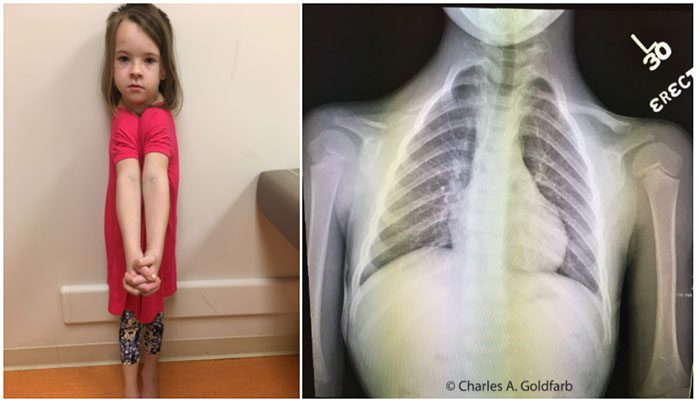Individuals affected by this condition face many challenges including short stature, partial skull absence, and respiratory issues.
Corey Bennett, who lives in Indiana, USA, has recently become a well-known name on the Internet. The reason for Corey’s fame is his remarkable abilities such as clapping his shoulders together, crushing a beer can with his shoulders, and folding his shoulders in half.
Rare Genetic Disorder
Corey suffers from a rare genetic syndrome known as Cleidocranial Dysplasia (CCD). According to information he shared on his TikTok channel, which has over 500,000 followers, Corey lacks collarbones. Additionally, the young man experiences underdeveloped cheekbones, short stature, and hearing loss.
The condition of Cleidocranial Dysplasia also affects the teeth, spine, skull, and limbs of those afflicted. According to the NY Post, Corey also admits that his teeth are quite unattractive.

Corey Bennett can fold his shoulders in half. (Photo: NY Post).
In an interview with LadBible, Corey shared that he was often bullied as a child due to his unusual condition. Consequently, he decided to do something different by clapping his shoulders together, spreading awareness, and publicly sharing his condition with many people.
After posting these videos on social media, many individuals with similar conditions reached out to Corey. He received hundreds of thousands of shares and comments with messages of empathy. However, Corey also faced a fair share of harsh criticism and rude comments.
Despite this, he insists that he will continue creating similar videos to help those around him understand the difficulties he faces due to this condition. He also aims to spread a positive message to anyone experiencing similar challenges or suffering from rare diseases.
How Dangerous is Cleidocranial Dysplasia?
Corey is not the first person in the world to have this syndrome. According to NBC News, in early February 2020, Gaten Matarazzo, a star from the series Stranger Things, underwent surgery to remove 14 extra teeth due to Cleidocranial Dysplasia. Like Corey, the condition caused the 19-year-old star to be born without collarbones, resulting in extra teeth in his gums.
The first cases of Cleidocranial Dysplasia were documented in 1765. However, at that time, doctors had not accurately identified the syndrome.

Actor Gaten Matarazzo is one of the few people in the world with Cleidocranial Dysplasia. (Photo: NBC News).
According to documentation from the National Organization for Rare Disorders in the United States, Cleidocranial Dysplasia is a rare condition with an incidence of 1 in 1,000,000. Current medical literature reports a total of 1,000 cases of this condition. The symptoms are apparent at birth, and the likelihood of affecting males and females is roughly equal.
Characteristics of individuals with Cleidocranial Dysplasia include short stature, facial abnormalities (prominent forehead, unusually wide face, small upper jaw), narrow and sloping shoulders due to the absence of collarbones. Additionally, they may experience skull defects (fontanelle), enlarged skullcap, and deformities in the pelvis, pubic bone, and thoracic region.
Patients often have delayed tooth eruption, with some experiencing cysts around teeth that prevent proper growth or cause misalignment, resulting in cleft lip and palate. They typically exhibit short stature, high palates, wide pelvic joints, non-fused lower jaw joints, and uneven finger lengths.
Cleidocranial Dysplasia also leads to mandibular hypoplasia, causing the pelvis to tilt to one side and spinal curvature.
The most serious risk is a high susceptibility to ear infections, recurrent sinus issues, complications with the upper respiratory tract, and hearing loss.

X-ray image of collarbones of a patient with Cleidocranial Dysplasia. (Photo: Charles A. Goldfarb).
According to documentation from Johns Hopkins Medicine, patients exhibit abnormalities due to a mutation in the RUNX2 gene, found on the sixth chromosome.
This gene plays a crucial role in the formation of osteoblasts, the cells that create bone in the developing body; it also helps shape chondrocytes (which produce cartilage) as individuals mature. The risk of passing this abnormal gene from affected parents to their children is 50% with each pregnancy, regardless of the child’s gender.
Cleidocranial Dysplasia currently has no prevention methods or definitive treatments. Patients must live with the condition throughout their lives. Depending on the issues they face, patients may receive orthodontic treatment or surgical intervention as necessary.
On CCD Smiles, a platform dedicated to individuals with this syndrome, many patients share their experiences living with this rare condition.
Kyle (who did not disclose his age or location) began dental interventions at just 5 years old. He underwent multiple surgeries and over 8 years of orthodontic treatment due to irregularly growing teeth. After 24 years, Kyle finally achieved a normal set of teeth. The man cried when he first saw his complete smile, with no teeth growing in the wrong position.




















































